Service Life Prediction and Lateral Bearing Capacity Analysis of Piles Considering Coupled Corrosion-Temperature Deterioration Processes
Abstract
1. Introduction
2. Basic Model for Service Life Prediction
3. Service Life Prediction Models
3.1. Effects of Temperature
3.2. Deterministic Model for Corrosion Initiation
3.3. Probabilistic Model for Corrosion Initiation
3.4. Prediction Model for Corrosion Propagation
4. Illustrative Example
4.1. Time to Corrosion Initiation Using the Deterministic Method
4.2. Time to Corrosion Initiation Using the Probabilistic Method
4.3. Time to Corrosion Propagation
5. Lateral Bearing Capacity Analysis of Piles
5.1. Performance Fuctions
5.2. Bearing Capacity Analysis
6. Conclusions
- Temperature has substantial influences on the activation energy, evaporable water content and ratio of binding capacity. These parameters can change the chloride diffusion rate which imposes a threat on the service life of RC piles. The steel surface chloride content at 50 °C is 5-fold of that at 10 °C;
- The probabilistic method is conservative compared to the deterministic method. Compared with the time to corrosion initiation, the time to propagation is much shorter;
- High temperatures can intensify the current density, which determines the corrosion rate of the reinforcement. The stiffness degradation coefficient of the pile is highly influenced by the reinforcement corrosive depth. The coefficient decreases rapidly when the protective layer of the reinforcing steel is destroyed.
- The behaviour of laterally loaded piles in chloride environments is analysed based on the stiffness degradation coefficient from the perspectives of the shear force, displacement and bending moment of piles.
Author Contributions
Funding
Institutional Review Board Statement
Informed Consent Statement
Data Availability Statement
Conflicts of Interest
References
- Tang, L.; Utgenannt, P.; Boubitsas, D. Durability and Service Life Prediction of Reinforced Concrete Structures. In Proceedings of the 14th International Congress on the Chemistry of Cement, Beijing, China, 13 October 2015. [Google Scholar]
- Weerdt, K.D.; Lothenbach, B.; Geiker, M.R. Comparing Chloride Ingress from Seawater and NaCl Solution in Portland Cement Mortar. Cem. Concr. Res. 2019, 115, 80–89. [Google Scholar] [CrossRef]
- Kim, A.T.V.; Mark, G.S. Structural Reliability of Concrete Bridges Including Improved Chloride Induced Corrosion Models. Struct. Saf. 2000, 22, 313–333. [Google Scholar] [CrossRef]
- Yu, C.W.; Bull, J.W. Durability of Materials and Structures in Building and Civil Engineering, 1st ed.; CRC Press: Boca Raton, FL, USA, 2006. [Google Scholar]
- Jiang, L.H.; Li, C.Z.; Zhu, C.L.; Song, Z.J.; Chu, H.Q. The Effect of Tensile Fatigue on Chloride Ion Diffusion in Concrete. Constr. Build. Mater. 2017, 151, 119–126. [Google Scholar] [CrossRef]
- Shao, W.; Li, J.P.; Liu, Y. Influence of Exposure Temperature on Chloride Diffusion into RC Pipe Piles Exposed to Atmospheric Corrosion. J. Mater. Civ. Eng. 2016, 28, 1–8. [Google Scholar] [CrossRef]
- Apostolopoulos, C.A.; Papadakis, V.G. Consequences of Steel Corrosion on the Ductility Properties of Reinforcement Bar. Constr. Build. Mater. 2008, 22, 2316–2324. [Google Scholar] [CrossRef]
- Isteita, M.; Xi, Y. The Effect of Temperature Variation on Chloride Penetration in Concrete. Constr. Build. Mater. 2017, 156, 73–82. [Google Scholar] [CrossRef]
- Hussain, S.E.; Rasheeduzzafar; Al-Musallam, A.; Al-Gahtani, A.S. Factors Affecting Threshold Chloride for Reinforcement Corrosion in Concrete. Cem. Concr. Res. 1995, 25, 1543–1555. [Google Scholar] [CrossRef]
- Liu, T.; Weyers, R.W. Modeling the Dynamic Corrosion Process in Chloride Contaminated Concrete Structures. Cem. Concr. Res. 2019, 28, 365–379. [Google Scholar] [CrossRef]
- Daniel, P.; Daniel, B.; Paul, M.; Kelly, J. Investigation and Initial Stability Analysis of a Wharf on Severely Deteriorated Steel H-Piles. In Proceedings of the American Society of Civil Engineers 15th Triennial International Conference, Pittsburgh, PA, USA, 15 September 2019; pp. 273–283. [Google Scholar] [CrossRef]
- Cui, X.Z.; Zhang, N.; Li, S.C.; Zhang, J.; Tang, W.Z. Deterioration of Soil-Cement Piles in a Saltwater Region and Its Influence on the Settlement of Composite Foundations. J. Perform. Constr. Fac. 2014, 04014195. [Google Scholar] [CrossRef]
- Tuutti, K. Swedish Foundation for Concrete Research Stockholm. In Corrosion of Steel in Concrete; CBI: Stockholm, Sweden, 1982; pp. 105–119. [Google Scholar]
- Amey, S.L.; Johnson, D.A.; Miltenberger, M.A.; Farzam, H. Predicting the Service Life of Concrete Marine Structures: An Environmental Methodology. ACI Struct. J. 1998, 95, 205–214. [Google Scholar]
- Bhaskar, S.; Radhakrishna, G.P.; Ravindra, G.; Bharatkumar, B.H.; Iyer, N.R. Use of Portland Pozzolana Cement to Enhance the Service Life of Reinforced Concrete Exposed to Chloride Attack. J. Mater. Civ. Eng. 2015, 27, 04015031. [Google Scholar] [CrossRef]
- Kwon, S.J.; Na, U.J.; Sang, S.P.; Sang, H.J. Service Life Prediction of Concrete Wharves with Early–aged Crack: Probabilistic Approach for Chloride Diffusion. Struct. Saf. 2009, 31, 75–83. [Google Scholar] [CrossRef]
- Jee, A.A.; Pradhan, B. Study on Development of Empirical Relationships Between Durability Parameters of Concrete Made with Different Types of Binder and Exposed to Chloride Environment. Constr. Build. Mater. 2019, 212, 799–817. [Google Scholar] [CrossRef]
- Khaghanpour, R.; Dousti, A.; Shekarchi, M. Prediction of Cover Thickness Based on Long-term Chloride Penetration in a Marine Environment. J. Perform. Constr. Fac. 2016, 31, 04016070. [Google Scholar] [CrossRef]
- Zhou, A.; Qin, R.; Chow, C.L.; Lau, D. Structural Performance of FRP Confined Seawater Concrete Columns under Chloride Environment. Compos. Struct. 2019, 216, 12–19. [Google Scholar] [CrossRef]
- Wang, Y.Z.; Liu, C.X.; Li, Q.M.; Wu, L.J. Chloride Ion Concentration Distribution Characteristics within Concrete Covering-layer Considering the Reinforcement Bar Presence. Ocean Eng. 2019, 173, 608–616. [Google Scholar] [CrossRef]
- Shao, W.; Li, J.P. Service Life Prediction of Cracked RC Pipe Piles Exposed to Marine Environments. Constr. Build. Mater. 2014, 64, 301–307. [Google Scholar] [CrossRef]
- Shao, W.; Shi, D.D.; Jiang, J.P.; Chen, Y.L. Time-dependent Lateral Bearing Behaviour of Corrosion-damaged RC Pipe Piles in Marine Environments. Constr. Build. Mater. 2017, 157, 676–684. [Google Scholar] [CrossRef]
- Collepardi, M.; Marcialis, A.; Turrizzani, R. The Kinetics of Penetration of Chloride Ions into the Concrete. Ind. Ital. Cem. 1970, 4, 157–164. [Google Scholar]
- Collepardi, M.; Marcialis, A.; Turrizzani, R. Penetration of Chloride Ions into Cement Pastes and Concretes. J. Am. Ceram. Soc. 1972, 55, 534–535. [Google Scholar] [CrossRef]
- Enrico, Z.; Caio, G.N. Chloride Diffusion Assessment in RC Structures Considering the Stress-strain State Effects and Crack Width Influences. Constr. Build. Mater. 2019, 201, 100–109. [Google Scholar] [CrossRef]
- Philip, V.H.; Michel, D.K.; Alice, E.; Annemie, A.; Nele, D.B. Service Life and Global Warming Potential of Chloride Exposed Concrete with High Volumes of Fly Ash. Cement Concrete Comp. 2017, 80, 210–223. [Google Scholar] [CrossRef]
- Emilio, B.A.; Philippe, B.; Alaa, C. Probabilistic Lifetime Assessment of RC Structures under Coupled Corrosion-fatigue Deterioration Processes. Struct. Saf. 2009, 31, 84–96. [Google Scholar] [CrossRef]
- Panesar, D.K.; Chidiac, S.E. Effect of Cold Temperature on the Chloride-Binding Capacity of Cement. J. Cold Reg. Eng. 2011, 25, 133–144. [Google Scholar] [CrossRef]
- Martin, P.B.; Zibara, H.; Hooton, R.D.; Thomas, M.D.A. A Study of the Effect of Chloride Binding on Service Life Predictions. Cem. Concr. Res. 2000, 30, 1215–1223. [Google Scholar] [CrossRef]
- Shazali, M.A.; Rahman, M.K.; Al-Gadhib, A.H.; Baluch, M.H. Transport Modeling of Chlorides with Binding in Concrete. Arab. J. Sci. Eng. 2012, 37, 469–479. [Google Scholar] [CrossRef]
- Brunauer, S.; Skalny, J.; Bodor, E. Adsorption on Non–porous Solids. J. Colloid Interface Sci. 1969, 30, 546–552. [Google Scholar] [CrossRef]
- Xi, Y.; Bazant, Z.; Jennings, H. Moisture Diffusion in Cementitious Materials-adsorption Isotherms. Adv. Cem. Based Mater. 1994, 1, 248–257. [Google Scholar] [CrossRef]
- Karolina, H.; Šmilauer, V.; Libor, J. Prediction of Reinforcement Corrosion Due to Chloride Ingress and its Effects on Serviceability. Eng. Struct. 2018, 174, 768–777. [Google Scholar] [CrossRef]
- Petcherdchoo, A.; Chindaprasirt, P. Exponentially Aging Functions Coupled with Time-dependent Chloride Transport Model for Predicting Service Life of Surface-treated Concrete in Tidal Zone. Cem. Concr. Res. 2019, 120, 1–12. [Google Scholar] [CrossRef]
- Shao, W.; Nie, Y.H.; Liang, F.Y.; Shi, D.D. A Novel Comprehensive Evaluation Method for the Corrosion Initiation Life of RC Hollow Piles in Chloride Environments. Constr. Build. Mater. 2020, 249, 118801. [Google Scholar] [CrossRef]
- Zheng, J.J.; Zhang, J.; Zhou, X.Z.; Wu, Y.F.; Ye, Y.M.; Wang, Y.H. A Three-step Analytical Scheme for Estimating the Steady-state Chloride Diffusion Coefficient of Mature Cement Paste. Constr. Build. Mater. 2018, 191, 1004–1010. [Google Scholar] [CrossRef]
- Xu, Q.H.; Shi, D.D.; Shao, W. Service Life Prediction of RC Square Piles Based on Time-varying Probability Analysis. Constr. Build. Mater. 2019, 227, 116824. [Google Scholar] [CrossRef]
- Comité Euro-International Du Béton (CEB). CEB-FIP Model Code for Service Life Design; The International Federation for Structural Concrete (FIB): Lausanne, Switzerland, 2006. [Google Scholar]
- Du, F.Y.; Jin, Z.Q.; She, W.; Xiong, C.S.; Feng, G.G.; Fan, J.F. Chloride Ions Migration and Induced Reinforcement Corrosion in Concrete with Cracks: A Comparative Study of Current Acceleration and Natural Marine Exposure. Constr. Build. Mater. 2020, 263, 120099. [Google Scholar] [CrossRef]
- Liu, Y.P. Modeling the Time-to-corrosion Cracking of the Cover Concrete in Chloride Contaminated Reinforced Concrete Structures. ACI Mater. J. 1996, 95, 675–681. [Google Scholar] [CrossRef]
- Poulos, H.G.; Davis, E.H. Pile Foundation Analysis and Design, 1st ed.; John Wiley & Sons: New York, NY, USA, 1980. [Google Scholar]
- Ministry of housing and Urban-Rural Development of the People’s Republic of China. Durability Evaluation Criteria for Concrete Structures; China Architecture & Building Press: Beijing, China, 2007.
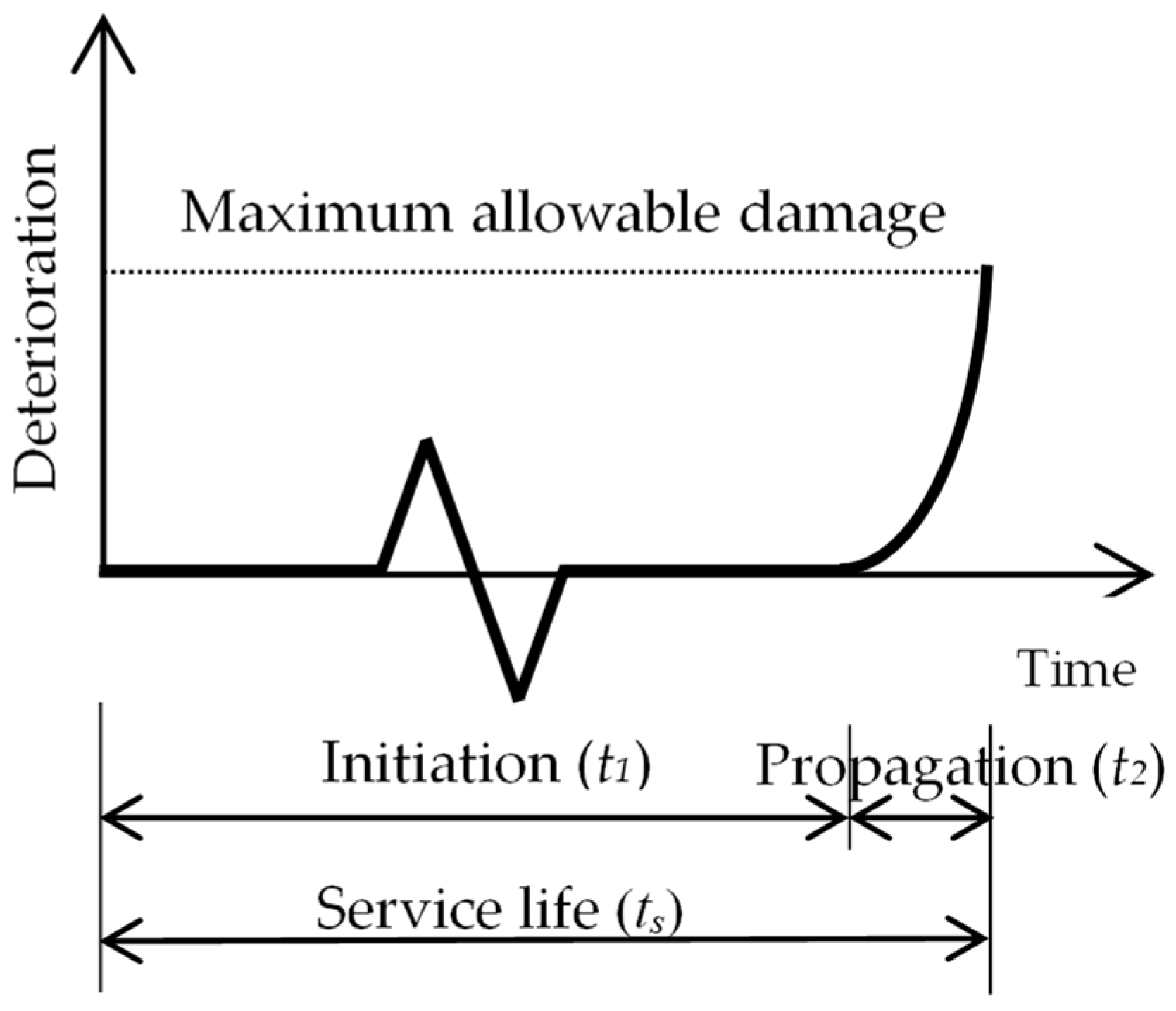
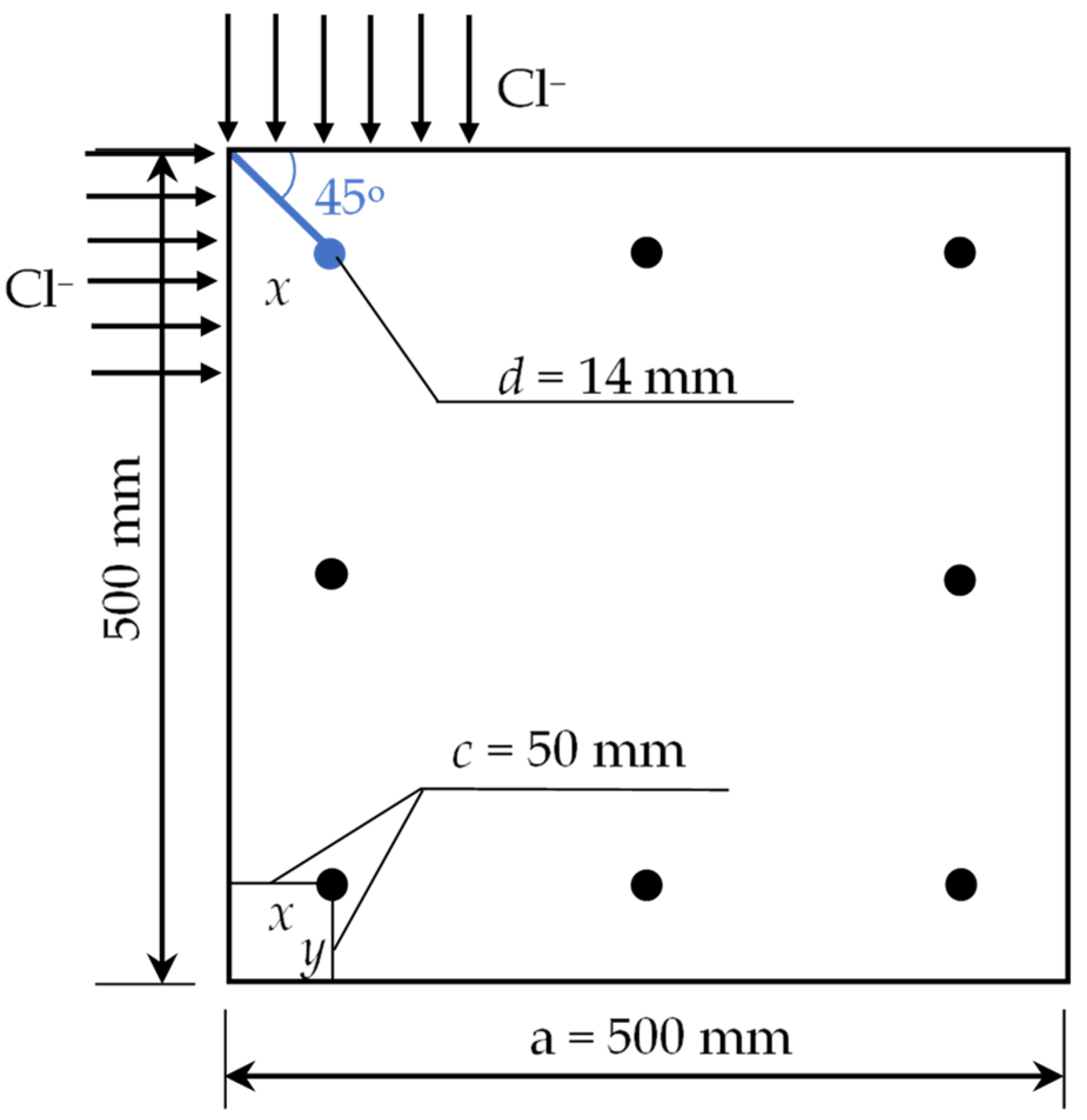
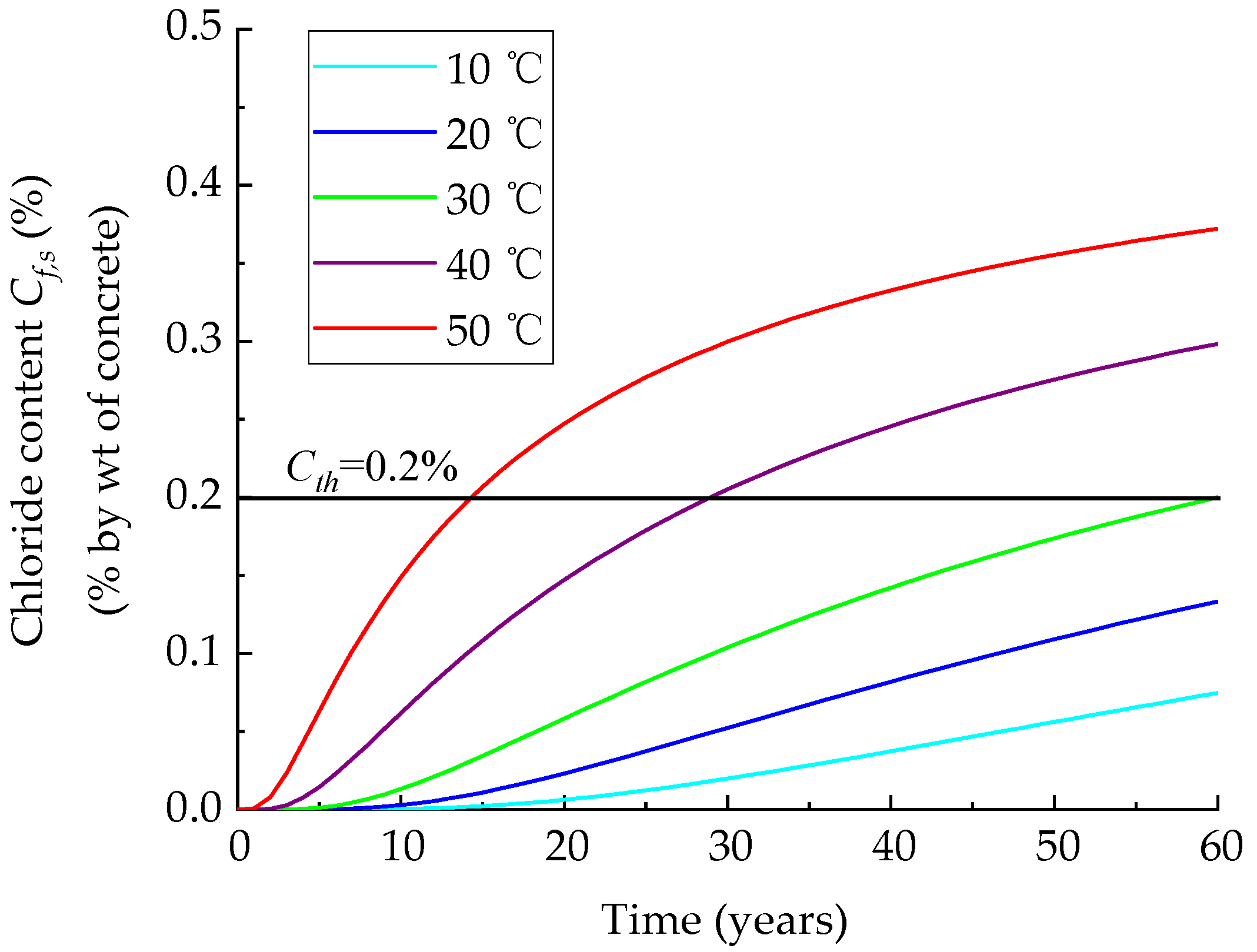

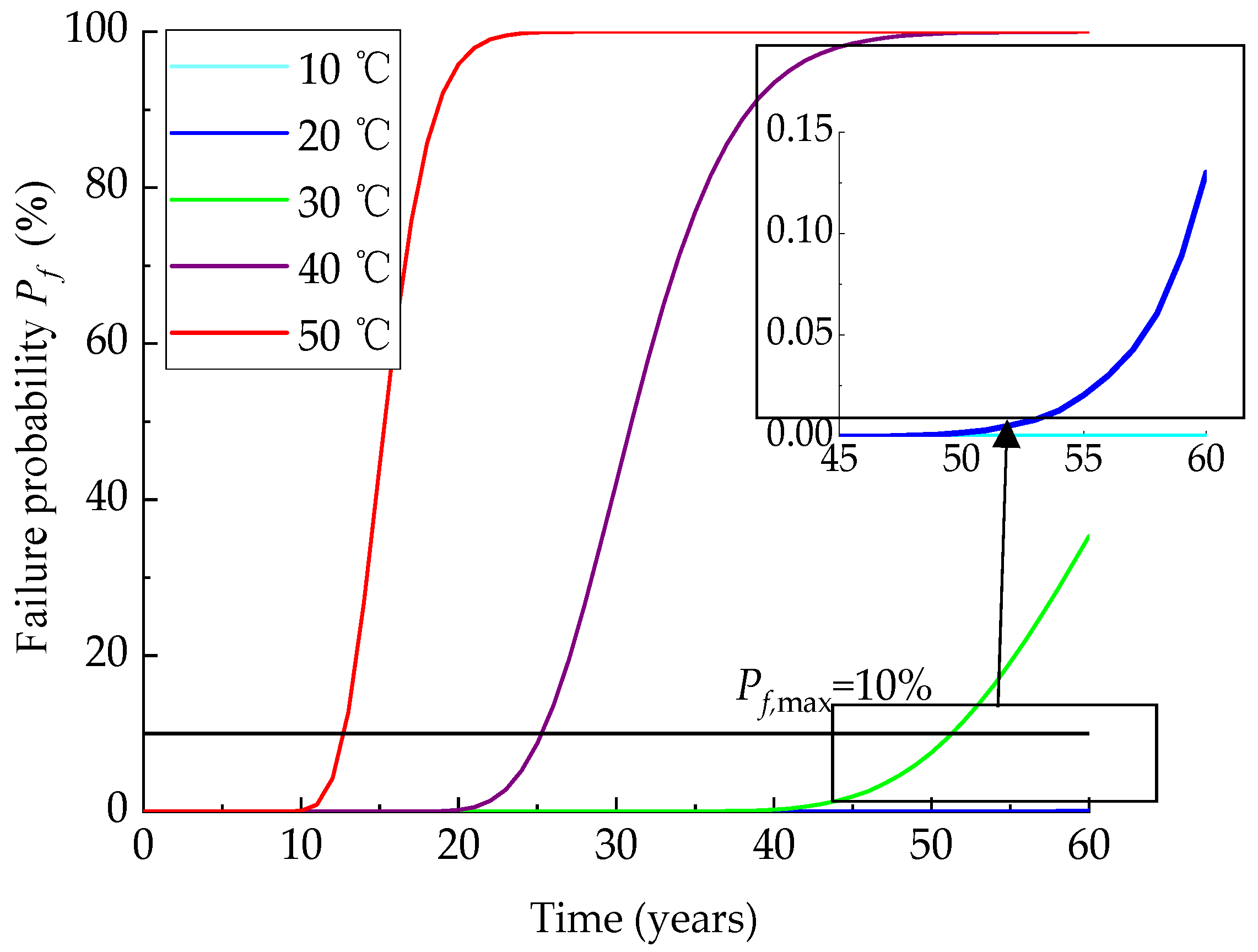
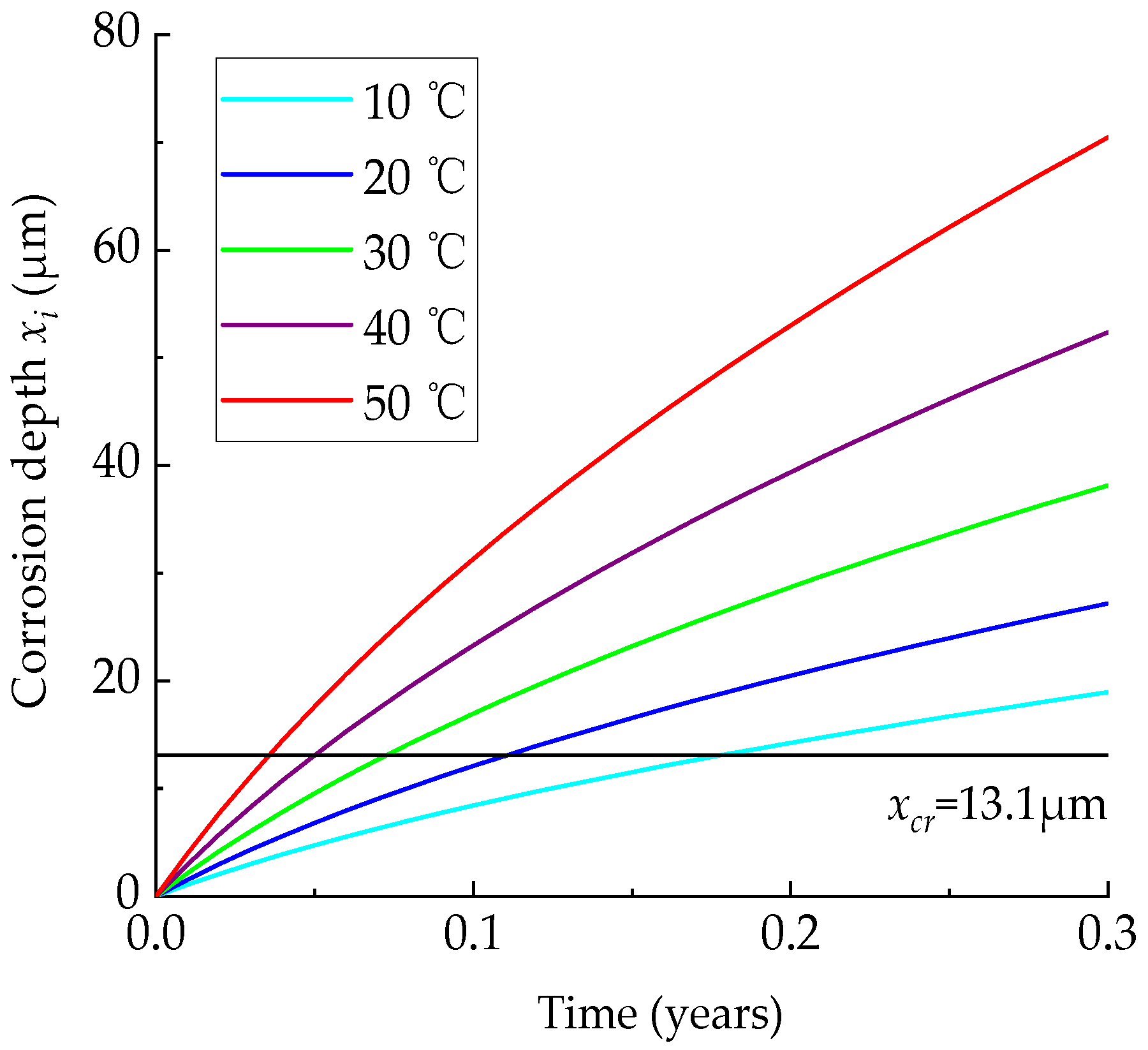
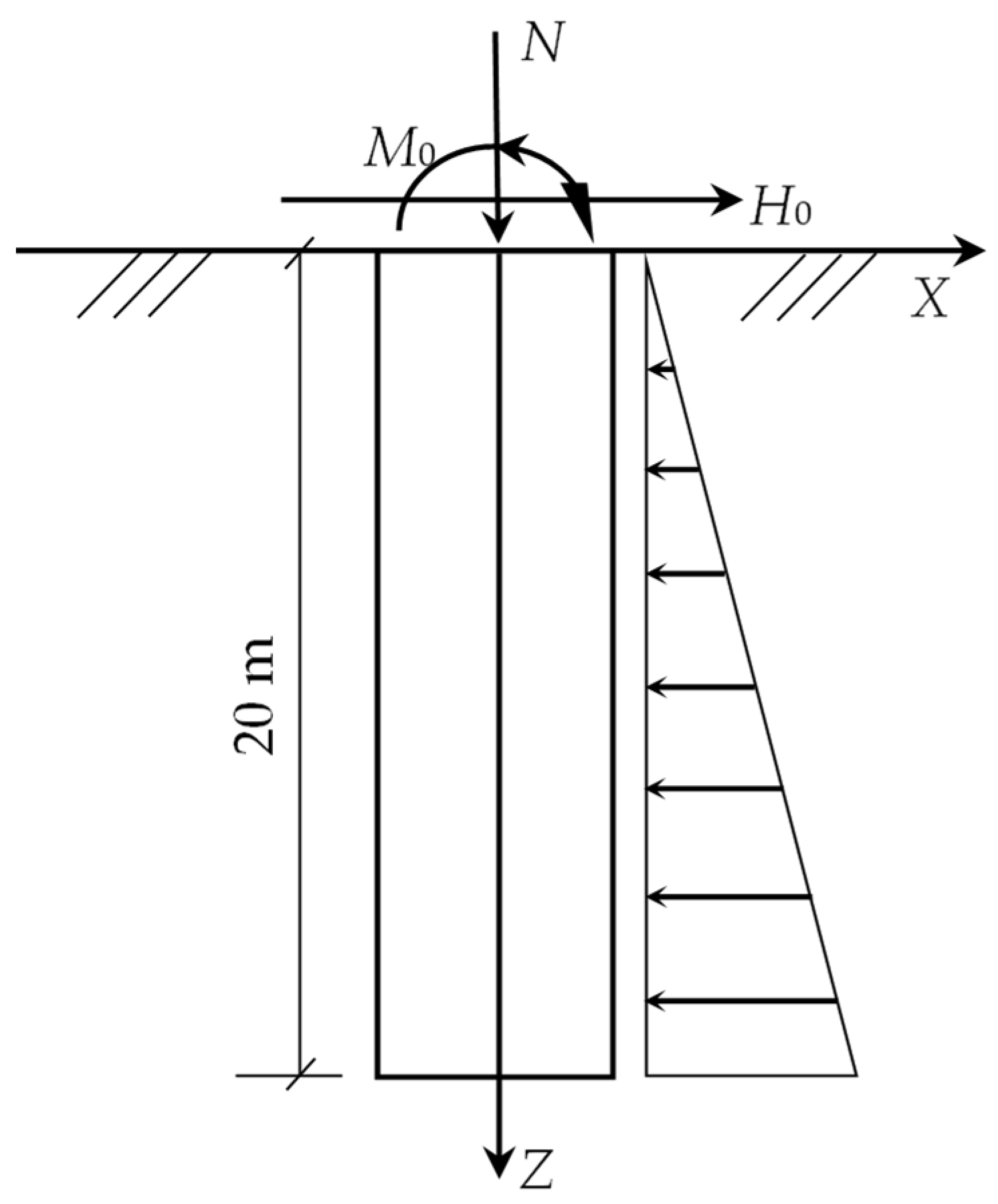
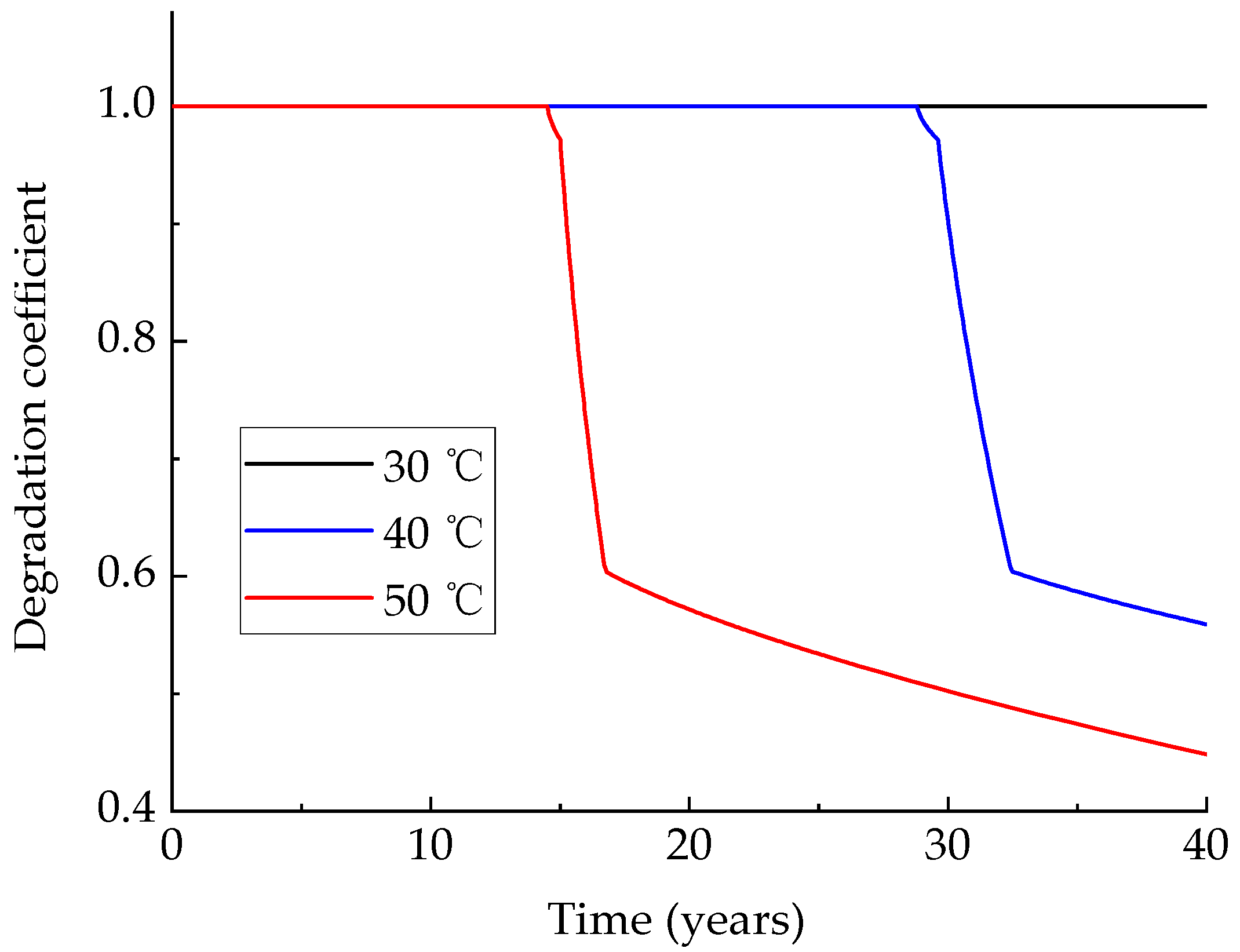
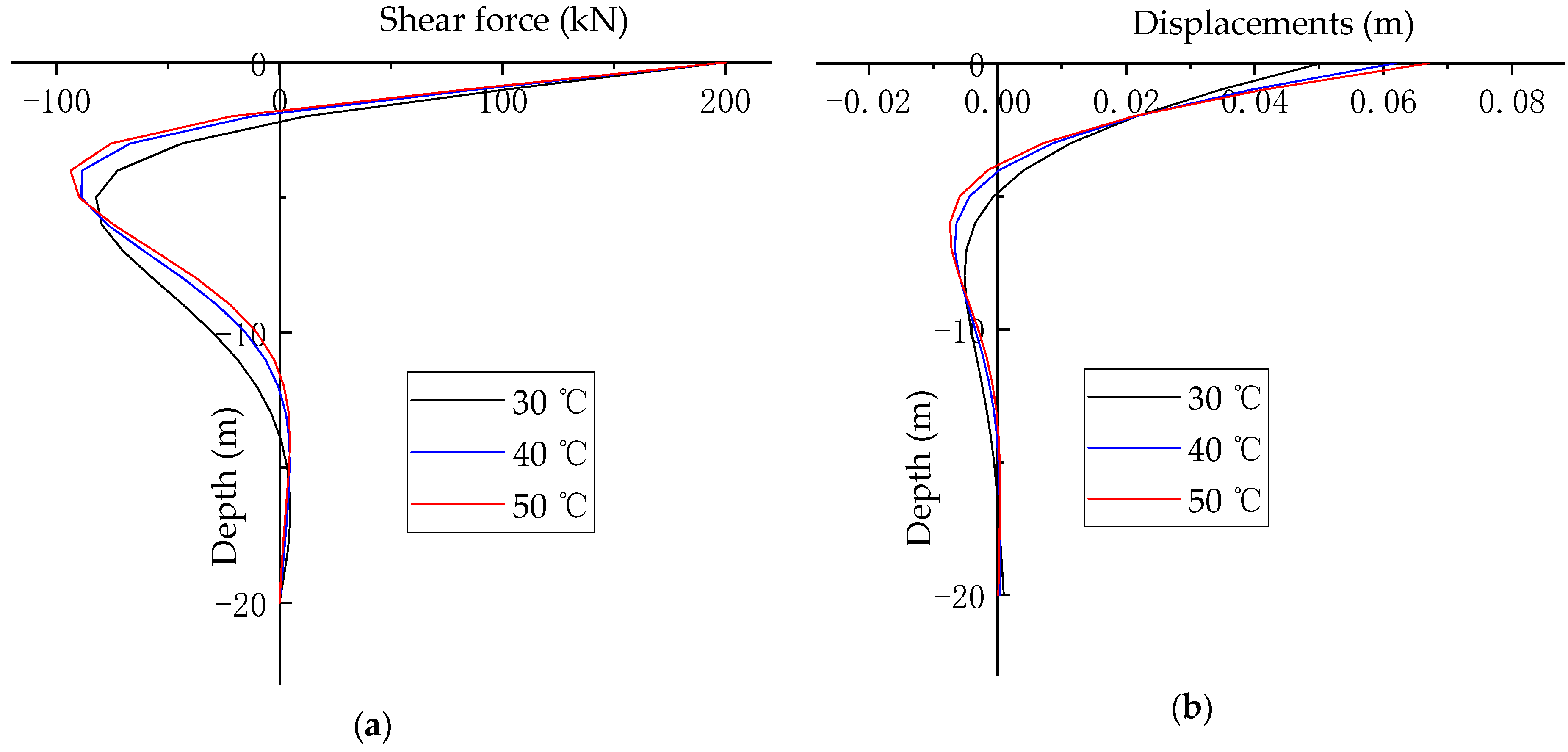

| Variable | Description | Value |
|---|---|---|
| C0 | Initial chloride concentration in concrete | 0 |
| Cs | Concrete surface chloride concentration | 0.5% [35] |
| Cth | The threshold concentration | 0.2% [35] |
| U | Activation energy | 41.8 kJ/mol [25] |
| R | Ideal gas constant | 8.31 × 10−3 kJ/mol/K [25] |
| D0 | Diffusion coefficient at time t0 (28d) | 5.98 × 10−12 m2/s [36] |
| t0 | Time for standard curing of concrete | 28 d |
| α | ∂Cb/∂Cf | 0.6, 0.8, 1.0, 0.93, 0.85 [6] |
| h | Humidity of pore in concrete | 1 |
| te | Hydration period | 60 × 365 d |
| m | The decay rate | 0.2 [16,34] |
| x,y = c | 0.05 m |
| Variable | Distribution | Mean | COV |
|---|---|---|---|
| Cs | Normal [35] | 0.5% | 0.1 |
| Cth | Uniform [3,27] | 0.2% | 0.19 |
| D0 | Normal [35] | 5.98 × 10−12 m2/s | 0.1 |
| T | Normal [37] | 10, 20, 30, 40, 50 °C | 0.1 |
| m | Normal [37] | 0.2 | 0.2 |
| Variable | Description | Value |
|---|---|---|
| M | Molar mass of Fe | 5.6 g/mol |
| n | Charge of reactive ion | 2.5 [39] |
| ρs | Density of Fe | 7.9 × 10 kg/m3 |
| C | Chloride ion threshold | 4.8 kg/m3 (Cth = 0.5%) |
| d0 | Diameter of steel | 14 mm |
| c | Thickness of cover | 50 mm |
| αv | Relative volume expansion ratio | 3 [41] |
| vc | Poisson’s ratio of the concrete | 0.2 [27] |
| fct | Tensile strength of the concrete | 2.39 MPa |
| Ec | Modulus of elasticity of the concrete | 3.25 × 104 MPa |
| φc | Creep coefficient of concrete | 2 |
| Temperature (°C) | Time to Initiation (yrs) | Time to xi (yrs) | xi (mm) | Ai (mm2) | ηi | η |
|---|---|---|---|---|---|---|
| 10, 20, 30 °C | 40 | 0 | 0 | 1 | 1 | |
| 40 °C | 28.8 | 11.2 | 0.51 | 42.12 × pi | 0.65 | 0.56 |
| 50 °C | 14.5 | 25.5 | 1.18 | 33.87 × pi | 0.65 | 0.45 |
| Variable | Description | Value |
|---|---|---|
| H0 | Horizontal load | 200 kN |
| N0 | Vertical load | 2000 kN |
| M0 | Moment | 300 kNm |
| kh | Proportional factor of the coefficient of the subgrade reaction | 3.0 MN/m4 |
| Ec | Modulus of elasticity of the concrete | 3.25 × 104 MPa |
| Ip | Moment of inertia of pile section | 0.54/12 m4 |
Publisher’s Note: MDPI stays neutral with regard to jurisdictional claims in published maps and institutional affiliations. |
© 2021 by the authors. Licensee MDPI, Basel, Switzerland. This article is an open access article distributed under the terms and conditions of the Creative Commons Attribution (CC BY) license (https://creativecommons.org/licenses/by/4.0/).
Share and Cite
Li, Y.; Chen, Y.; Shao, W.; Zhang, J.; Liao, S.; Fernandez-Steeger, T.M. Service Life Prediction and Lateral Bearing Capacity Analysis of Piles Considering Coupled Corrosion-Temperature Deterioration Processes. J. Mar. Sci. Eng. 2021, 9, 614. https://doi.org/10.3390/jmse9060614
Li Y, Chen Y, Shao W, Zhang J, Liao S, Fernandez-Steeger TM. Service Life Prediction and Lateral Bearing Capacity Analysis of Piles Considering Coupled Corrosion-Temperature Deterioration Processes. Journal of Marine Science and Engineering. 2021; 9(6):614. https://doi.org/10.3390/jmse9060614
Chicago/Turabian StyleLi, Yue, Youliang Chen, Wei Shao, Juhui Zhang, Shaoming Liao, and Tomas Manuel Fernandez-Steeger. 2021. "Service Life Prediction and Lateral Bearing Capacity Analysis of Piles Considering Coupled Corrosion-Temperature Deterioration Processes" Journal of Marine Science and Engineering 9, no. 6: 614. https://doi.org/10.3390/jmse9060614
APA StyleLi, Y., Chen, Y., Shao, W., Zhang, J., Liao, S., & Fernandez-Steeger, T. M. (2021). Service Life Prediction and Lateral Bearing Capacity Analysis of Piles Considering Coupled Corrosion-Temperature Deterioration Processes. Journal of Marine Science and Engineering, 9(6), 614. https://doi.org/10.3390/jmse9060614







